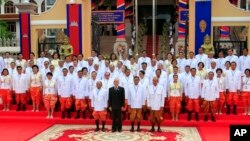With Prime Minister Hun Sen announcing a Cabinet reshuffle last week, political observers have drawn comparisons with Cambodia’s fellow Southeast Asian nation Myanmar, where the first democratically elected government in more than half a century is about to be formed.
Cambodia’s strongman leader, Prime Minister Hun Sen, announced that three long-serving ministers—Foreign Minister Hor Namhong, Minister of Land Management Im Chhun Lim and Deputy Prime Minister Keat Chhon—will all retire to make way for replacements. In a letter to the National Assembly, Hun Sen said ministers and high-ranking officials were being “exchanged” at eight ministries in total, in a reshuffle that will come into effect in early April.
But observers say Hun Sen’s attempts to create a narrative of reform surrounding the ruling Cambodian People’s Party (CPP) did not stand up to comparison with the sea change taking place in nearby Myanmar.
Myanmar, also known as Burma, has been under the rule of military dictators and their proxies since a 1962 coup. But the National League for Democracy won a resounding victory at November’s national elections and now dominates the parliament. Former prisoner of conscience Aung San Suu Kyi will take up a Cabinet position in the new government set to take power on April 1.
Hun Sen’s changes, meanwhile, are a largely superficial effort to alleviate pressure on the CPP, said Koul Panha, executive director of the Committee for Free and Fair Elections in Cambodia.
“The Cabinet of the ruling CPP government led by Prime Minister Hun Sen does not care much about efficiency,” he said. “For the most part, it focuses on stability in the government and political stage, especially the stability of the party.”
Myanmar looks set for more economic and social reforms that some hope will see the resource-rich country—long the sick man of Southeast Asia—leapfrog other nations. Suu Kyi’s choice for president, Htin Kyaw, has already slashed the number of ministries in the country’s central government from 36 to 21, indicating an effort to streamline government functions.
By contrast, Cambodia’s government is notoriously top heavy, reflecting Hun Sen’s use of political patronage to bolster his power. The Cabinet—which employs at least 270 people including administrative staff—still has nine deputy prime ministers. The country has a total of 26 ministries, not including the powerful Council of Ministers.
Additionally, some of the more senior members of the government are getting old and becoming even less dynamic, Panha said.
“The efficiency, energy and tenacity [of ministers] goes down with their age,” he said. “There is a new wave in the ruling party who want to garner experience in top government posts. This is a sort of pressure which led to premier to think about adjustments. Even though there’s hope of deep reform, in the end it is to no avail, since the Cabinet keeps on growing.”
Unlike Myanmar, Cambodia has had practically the same leadership since more than 30 years ago, when Hun Sen first ascended to the top of government, noted Ear Sophal, a professor at Occidental College in Los Angeles and the author of the book “Aid Dependence in Cambodia.”
Sophal agreed that last week’s reshuffle was largely for show, and not the genuine effort to reform the government it has been presented as.
“I am sure [Hun Sen] would like the people to believe that and maybe he even wants to do that, but frankly, it is not enough to promote from within and reshuffle an old card deck that has many torn cards,” he said by email.
“Who wants to do reform when the system itself remains the same? It is the same old wine in a new bottle. We need new wine!”
Prime Minister Hun Sen last Monday lauded his reshuffle, saying it would contribute to economic development by improving the efficiency of his administration.
“I just want to remind that even though you are old, you should bear a new work attitude,” the premier said during a speech at a Phnom Penh hotel.
“There’s no guarantee that there will always be positive change with a new face. However, the old faces adjusting their work attitude is something that’s strong. This is the third time we have adjusted our budget, and the average economic growth is now 7.7 percent—and in the last 10 years it has been 8.8 percent.
“If the people aren’t changing, how can there be economic growth?”
Ou Virak, director of local research center Future Forum, countered that minor personnel changes did not represent the “deep reform” needed in Cambodia’s government. “In Cambodia, there’s no reform, there’s only reshuffling,” he told VOA Khmer.
However, Virak cautioned, Myanmar is a very different case.
“Even though there is a regime change in Burma, the nation still faces many challenges and is not a model for Cambodia.
“The challenge is that the military still hold power in important ministries, such as the Ministry of Interior. This is a formula which protects the interests of the military in Burma.”
In some ways, Cambodia, which officially transitioned to democracy 1993, was ahead of Burma, which still faces tough challenges including ongoing conflicts with ethnic minorities, he said. “Cambodia has moved forward. It’s ‘older’ than Burma,” said Virak.







